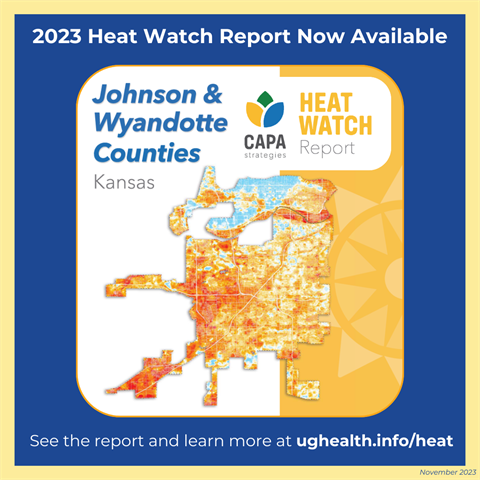2023 Kansas Community Heat Mapping Campaign Update
Published on November 29, 2023

Joint Press Release: Wyandotte County Public Health Department & Johnson County Department of Health and Environment
JOHNSON COUNTY/WYANDOTTE COUNTY, KAN. (Nov. 29, 2023) – This summer, the Johnson County Department of Health and Environment (JCDHE) and Wyandotte County Public Health Department (WYCO PHD) worked together on the Kansas Community Heat Watch, an urban heat island mapping campaign. On Aug, 12, 200 volunteers traveled 31 unique routes to collect over 200,000 temperature and humidity data points throughout 310 square miles of the two counties. The goal was to collect data about the distribution of heat as part of a regional effort to map where people are most at risk during extreme heat waves.
Findings included large temperature differences between the hottest and coolest communities throughout the day, with the biggest difference, 11.7 degrees F, occurring in the evening. Though the recorded high temperature for the Kansas City metropolitan area on Aug. 12 was 91 degrees F during the afternoon, the official records don’t tell the whole story. Data from the Heat Mapping Campaign clearly demonstrate that temperatures can vary substantially throughout communities in the region. In the hottest area on the map, the afternoon temperature approached 97 degrees F, while the coolest areas were about 85 degrees F.
The heat index (what the temperature feels like when the effect of humidity on air temperature is included) reached over 100 degrees F in the hottest neighborhoods in the afternoon, while staying under 90 (89.7) degrees F in the coolest parts of the counties.
"The distribution of heat is not felt equally among our communities. We look forward to using this information to develop community-driven strategies to lessen the burden of extreme heat in our neighborhoods,” said Jackson Ward, JCDHE epidemiologist.
According to JCDHE and WYCO PHD, the next steps are to strategize with other departments, partners, and community members on ways to mitigate the dangers of extreme heat in area neighborhoods and to develop interactive maps using the data from the campaign.
“Heat islands tend to be hotter than in areas with more green space, and that increases the risk of respiratory illnesses, heat exhaustion, heat stroke and heat-related deaths,” said Hannah Conner, WYCO PHD Social Epidemiologist. “Neighborhoods most impacted by historical discriminatory policies tend to feel this higher heat. By having a more detailed map of the hottest places in our counties, work can be focused to reduce the negative effects of increased heat.”
To learn more about the campaign and view results, visit: www.jocogov.org/spotthehot or ughealth.info/heat.
JCHDE and WYCO PHD are leading the Heat Mapping project in partnership with:
- Bridging the Gap
- CAPA Strategies
- City of Mission, Kan.
- City of Overland Park, Kan.
- CleanAirNow
- Groundwork Northeast Revitalization Group (Groundwork NRG)
- Heart to Heart International
- Johnson County Department of Technology & Innovation, Automated Information Mapping System group
- Johnson County Museum
- K-State Research and Extension, Johnson County
- Mid America Regional Council (MARC)
- National Oceanic and Atmospheric Administration (NOAA)
- National Weather Service (NWS)
- Unified Government of WyCo/KCK Department of Planning & Urban Design
- Unified Government of WyCo/KCK Department of Public Works
###